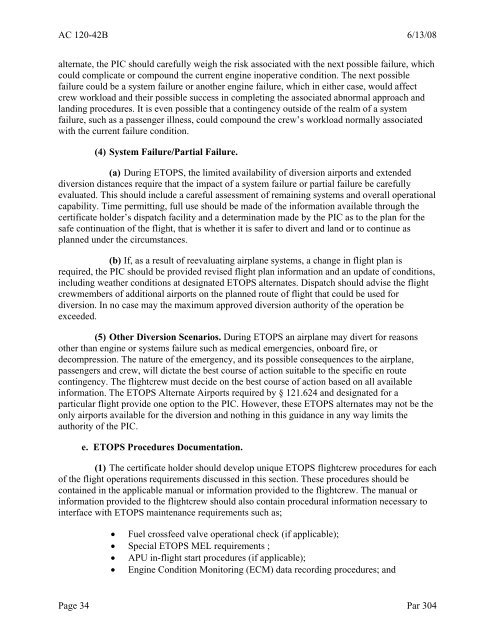AC 120-42B ETOPS and Polar Ops - Code7700
AC 120-42B ETOPS and Polar Ops - Code7700
AC 120-42B ETOPS and Polar Ops - Code7700
Create successful ePaper yourself
Turn your PDF publications into a flip-book with our unique Google optimized e-Paper software.
<strong>AC</strong> <strong>120</strong>-<strong>42B</strong> 6/13/08alternate, the PIC should carefully weigh the risk associated with the next possible failure, whichcould complicate or compound the current engine inoperative condition. The next possiblefailure could be a system failure or another engine failure, which in either case, would affectcrew workload <strong>and</strong> their possible success in completing the associated abnormal approach <strong>and</strong>l<strong>and</strong>ing procedures. It is even possible that a contingency outside of the realm of a systemfailure, such as a passenger illness, could compound the crew’s workload normally associatedwith the current failure condition.(4) System Failure/Partial Failure.(a) During <strong>ETOPS</strong>, the limited availability of diversion airports <strong>and</strong> extendeddiversion distances require that the impact of a system failure or partial failure be carefullyevaluated. This should include a careful assessment of remaining systems <strong>and</strong> overall operationalcapability. Time permitting, full use should be made of the information available through thecertificate holder’s dispatch facility <strong>and</strong> a determination made by the PIC as to the plan for thesafe continuation of the flight, that is whether it is safer to divert <strong>and</strong> l<strong>and</strong> or to continue asplanned under the circumstances.(b) If, as a result of reevaluating airplane systems, a change in flight plan isrequired, the PIC should be provided revised flight plan information <strong>and</strong> an update of conditions,including weather conditions at designated <strong>ETOPS</strong> alternates. Dispatch should advise the flightcrewmembers of additional airports on the planned route of flight that could be used fordiversion. In no case may the maximum approved diversion authority of the operation beexceeded.(5) Other Diversion Scenarios. During <strong>ETOPS</strong> an airplane may divert for reasonsother than engine or systems failure such as medical emergencies, onboard fire, ordecompression. The nature of the emergency, <strong>and</strong> its possible consequences to the airplane,passengers <strong>and</strong> crew, will dictate the best course of action suitable to the specific en routecontingency. The flightcrew must decide on the best course of action based on all availableinformation. The <strong>ETOPS</strong> Alternate Airports required by § 121.624 <strong>and</strong> designated for aparticular flight provide one option to the PIC. However, these <strong>ETOPS</strong> alternates may not be theonly airports available for the diversion <strong>and</strong> nothing in this guidance in any way limits theauthority of the PIC.e. <strong>ETOPS</strong> Procedures Documentation.(1) The certificate holder should develop unique <strong>ETOPS</strong> flightcrew procedures for eachof the flight operations requirements discussed in this section. These procedures should becontained in the applicable manual or information provided to the flightcrew. The manual orinformation provided to the flightcrew should also contain procedural information necessary tointerface with <strong>ETOPS</strong> maintenance requirements such as;• Fuel crossfeed valve operational check (if applicable);• Special <strong>ETOPS</strong> MEL requirements ;• APU in-flight start procedures (if applicable);• Engine Condition Monitoring (ECM) data recording procedures; <strong>and</strong>Page 34 Par 304
















